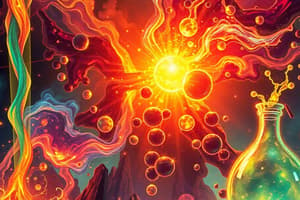Podcast
Questions and Answers
कौन से विधि में कॉपर आयन को कॉपर धातु में घटाया जाता है?
कौन से विधि में कॉपर आयन को कॉपर धातु में घटाया जाता है?
- उप-घटना (correct)
- ऑक्सिडेशन
- जलंधारण
- न्यूट्रलाइजेशन
किस प्रकार के अभिक्रियाओं में चर्बी के अणु ऑक्सीजन के साथ प्रतिक्रिया करते हैं?
किस प्रकार के अभिक्रियाओं में चर्बी के अणु ऑक्सीजन के साथ प्रतिक्रिया करते हैं?
- इलेक्ट्रोलाइसिस अभिक्रिया
- समस्पर्शन अभिक्रिया
- समाप्ति अभिक्रिया
- जलमंथन अभिक्रिया (correct)
सौर्य संयंत्र में, कौन सा प्रकार का परिवर्तन होता है?
सौर्य संयंत्र में, कौन सा प्रकार का परिवर्तन होता है?
- मोलक्यूलर संमिलन
- परमाणु-संरेखित प्रक्रिया
- सौर प्रतिक्रिया (correct)
- परमाणु संश्लेषण
संतुलनीयकरण अभिक्रिया में, कौन सा पदार्थ उत्पन्न होता है?
संतुलनीयकरण अभिक्रिया में, कौन सा पदार्थ उत्पन्न होता है?
संयुक्तिकरण प्रतिक्रिया किसे कहलाती है?
संयुक्तिकरण प्रतिक्रिया किसे कहलाती है?
किस प्रकार की प्रतिक्रिया में एक एकल यौगिक दो से अधिक सरल उत्पादों में विघटित होता है?
किस प्रकार की प्रतिक्रिया में एक एकल यौगिक दो से अधिक सरल उत्पादों में विघटित होता है?
कौनसी प्रक्रिया में एक संघातक एक कम्पाउंड में से दूसरे को हटा कर, दो नए उत्पादों की रचना करता है?
कौनसी प्रक्रिया में एक संघातक एक कम्पाउंड में से दूसरे को हटा कर, दो नए उत्पादों की रचना करता है?
सुल्फुरिक अम्ल और पोटैशियम हाइड्राइक्साइड के मामले में, कौनसी प्रतिक्रिया होती है?
सुल्फुरिक अम्ल और पोटैशियम हाइड्राइक्साइड के मामले में, कौनसी प्रतिक्रिया होती है?
रेडॉक्स प्रतिक्रिया में क्या होता है?
रेडॉक्स प्रतिक्रिया में क्या होता है?
Flashcards are hidden until you start studying
Study Notes
Types of Chemical Reactions
Chemical reactions are transformations where substances, known as reactants, change into different substances called products. These transformations can be categorized into several types based on the nature of the products and the process involved.
1. Synthesis Reactions (Combination)
Reactants combine to form a single product. For example, hydrogen gas and oxygen gas combine to form water:
[\ce{2H2(g) + O2(g) \rightarrow 2H2O(l)} \nonumber]
2. Decomposition Reactions
A single compound breaks down into two or more simpler products. For instance, calcium carbonate decomposes into calcium oxide and carbon dioxide when heated:
[\ce{CaCO3(s) \rightarrow CaO(s) + CO2(g)} \nonumber]
3. Single Displacement Reactions (Metathesis)
One reactant replaces another in a compound, forming two new products. In the reaction between zinc and copper sulfate, zinc displaces copper in the compound, producing zinc sulfate and copper metal:
[\ce{Zn(s) + CuSO4(aq) \rightarrow ZnSO4(aq) + Cu(s)} \nonumber]
4. Double Displacement Reactions (Exchange)
Two compounds exchange anions or cations, forming two new products. For example, in the neutralization of an acid and a base, water forms as well as a salt:
[\ce{HCl(aq) + NaOH(aq) \rightarrow NaCl(aq) + H2O(l)} \nonumber]
5. Redox Reactions (Oxidation-Reduction)
Atoms lose or gain electrons, leading to a change in oxidation state. In electrolysis, copper ions are reduced to copper metal, while water is oxidized to oxygen gas:
[\ce{Cu2+(aq) + 2e- \rightarrow Cu(s)} \qquad \ce{2H2O(l) \rightarrow O2(g) + 4H+(aq) + 4e-} \nonumber]
6. Combustion Reactions
Organic compounds react with oxygen to form carbon dioxide and water, with the release of heat and light:
[\ce{C8H18(g) + 5O2(g) \rightarrow 8CO2(g) + H2O(l)} \nonumber]
7. Acid-Base Reactions (Neutralization)
Acids and bases react to form water and a salt:
[\ce{HCl(aq) + NaOH(aq) \rightarrow NaCl(aq) + H2O(l)} \nonumber]
These types of reactions are not exhaustive, but they cover many important chemical transformations found in nature and everyday life. Understanding these types of reactions helps to enhance our comprehension of how the chemical world works.
Studying That Suits You
Use AI to generate personalized quizzes and flashcards to suit your learning preferences.




